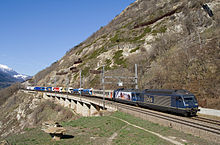This article needs additional citations for verification. (May 2009) |


In rail transportation, a rolling highway or rolling road is a form of combined transport involving the conveying of road trucks by rail, referred to as Ro-La trains. The concept is a form of piggyback transportation.
The technical challenges to implement rolling highways vary from region to region. In North America, the loading gauge is often high enough to accommodate double stack containers, so the height of a semi-trailer on a flatcar is no issue. However, in Europe, except for purpose built lines such as the Channel Tunnel or the Gotthard Base Tunnel, the loading gauge height is much smaller, and it is necessary to transport the trailers with the tires about 30 cm (11.81 in) above the rails, so the trailers cannot be simply parked on the surface of a flat car above the wagon wheels or bogies. Making the wagon wheels smaller limits the maximum speed, so many designs allow the trailer to be transported with its wheels lower than the rail wagon wheels. An early approach in France was the Kangourou wagon[1] with modified trailers. This technology did not survive, due to the market resistance to modified trailers. Today, three designs for these special wagons are in commercial service, "Modalohr", "CargoBeamer" and "Niederflurwagen" [2] [3] [4] .
During a rolling-highway journey, if the drivers accompany the trailer, they are accommodated in a passenger car or a sleeping car. At both ends of the rail link there are purpose-built terminals that allow the train to be easily loaded and unloaded.
- ^ http://roadmaster-087.skyrock.com/3197907081-SNCF-Kangourou.html Piggyback transport in the 60s video in French
- ^ https://www.railcargo.com/de/leistungen/wagenladungen/equipment/gueterwagen/niederflurwagen Rail Cargo Group (28 December 2021). "Niederflurwagen (European compatible car that allows linear loading)". www.railcargo.com/. Retrieved 28 December 2021.
- ^ Ralpin (28 December 2021). "Ralpin". www.ralpin.com/. Retrieved 28 December 2021.
- ^ modadaten (28 December 2021). "Niederflurwagen". www.mobadaten.info. Retrieved 28 December 2021.